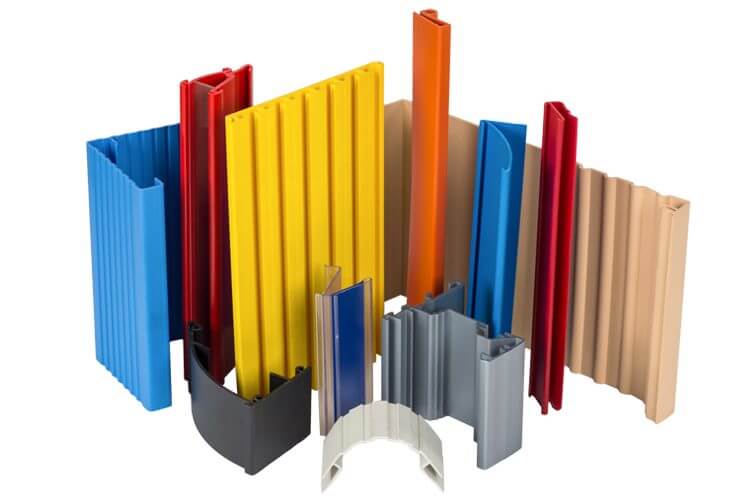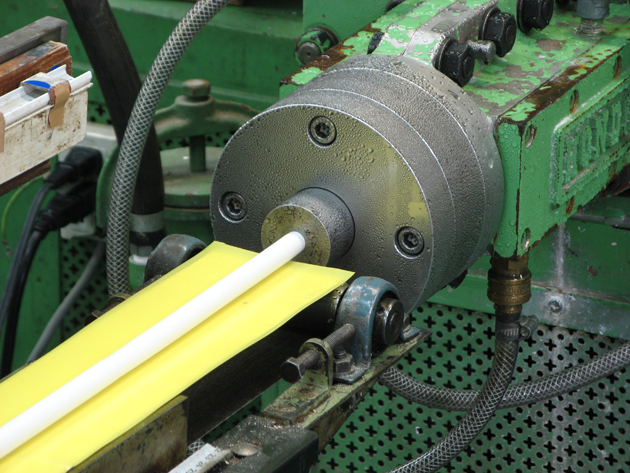The three major materials commonly used in the extrusion process are polymers, metals, and ceramics for various applications.

Polymer Extrusion
Here’s a breakdown of the process:
- Melting: Raw polymer material, often in pellet form, is fed into the extruder where it is heated until it reaches a molten state.
- Shaping: The molten polymer is then forced, or extruded, through a shaped die, which gives it its final form.
- Cooling: The extruded polymer is cooled, often with air or water, to solidify and maintain its shape.
- Cutting or Rolling: Depending on the final product, the polymer might be cut into desired lengths or rolled onto spools.
Commonly Extruded Polymers
Some of the most commonly extruded polymers include:
- Polyethylene (PE): This is a widely used plastic, known for its versatility and low cost.
- Polypropylene (PP): Another common plastic, PP is appreciated for its resistance to chemicals and high melting point.
- Polyvinyl Chloride (PVC): Often used in construction for things like pipes and vinyl siding.
- Polystyrene (PS): Frequently used for disposable cutlery, CD cases, and many other applications.

Benefits and Limitations of Polymer Extrusion
Polymer extrusion offers numerous advantages but also comes with certain limitations.
Benefits:
- High Efficiency: Large volumes of products can be produced in a relatively short time.
- Versatility: A wide range of products and shapes can be manufactured using polymer extrusion.
- Continuous Process: Ideal for producing long lengths of a product, like pipes or long rolls of film.
Limitations:
- Material Limitations: Not all polymers are suitable for extrusion, especially those with very high melting temperatures or those that degrade easily upon heating.
- Initial Setup Cost: Setting up an extrusion line can be expensive, though the cost per unit produced is often low.
Metal Extrusion
Introduction to Metal Extrusion
Metal extrusion is a process that involves forcing metal through a die to create a desired cross-sectional profile. Unlike polymer extrusion, which typically uses heat to melt the material, metal extrusion often uses either hot or cold processes, depending on the metal and the desired properties. Here’s a basic breakdown:
- Preparation: The metal billet is preheated to a specific temperature to make it pliable.
- Extrusion: The preheated billet is then placed in the chamber and pushed through a die using high pressure.
- Finishing: The extruded metal may undergo various finishing processes, such as cutting, straightening, or heat treatment to achieve the desired characteristics.
Some of the most prominent include
- Aluminum: Lightweight and corrosion-resistant, making it a popular choice for a multitude of applications.
- Brass: An alloy of copper and zinc, known for its malleability and attractive finish.
- Copper: Excellent electrical conductivity makes it ideal for electrical applications.
- Steel Alloys: Offer strength and durability; however, they typically require higher forces for extrusion.
Factors Affecting Metal Extrusion Several factors can influence the quality and efficiency of the metal extrusion process:
Temperature: The billet’s temperature and the extrusion environment can significantly affect the metal’s flow and the final product’s properties.
Die Design: The shape and design of the die determine the profile of the extruded metal. A well-designed die can enhance the flow of metal and reduce defects.
Billet Quality: Any impurities or inconsistencies in the billet can lead to defects in the extruded product.
Lubrication: Proper lubrication between the billet and the container can reduce friction, preventing defects and improving the final product’s quality.
Ceramic Extrusion
Basics of Ceramic Extrusion Ceramic extrusion is the process of shaping ceramic materials into specific profiles by pushing them through a die. Unlike metals or polymers, ceramics don’t melt in the traditional sense.
- Preparation: Ceramic powders are mixed with additives and water to form a plastic mass or paste suitable for extrusion.
- Extrusion: The ceramic mix is then fed into an extruder and pushed through a specific die to achieve the desired profile.
- Drying: Post-extrusion, the ceramic shape is dried to remove any remaining moisture.
- Firing: The dried ceramic product is then fired in a kiln to achieve its final hardness and strength.
Types of Ceramics Used in Extrusion
- Alumina (Al2O3): Known for its high temperature and wear resistance, commonly used in industrial applications.
- Zirconia (ZrO2): Offers exceptional strength and toughness, making it ideal for cutting tools and dental ceramics.
- Cordierite: Used in kiln furniture and as a substrate in catalytic converters due to its low thermal expansion.

Advantages and Disadvantages of Ceramic Extrusion
Advantages:
- Versatility: Can create complex profiles and shapes which might be challenging with other forming methods.
- Efficiency: Suitable for mass production of certain ceramic products like tiles and honeycomb structures.
- Uniformity: Offers consistent material properties and dimensions for the extruded parts.
Disadvantages:
- Brittleness: Ceramics, in general, are brittle, and extruded parts may require careful handling to avoid breakage.
- Shrinkage: During the firing process, ceramic parts can shrink, leading to dimensional inconsistencies.
- Material Limitations: Not all ceramic materials are amenable to extrusion, and the choice of material can significantly impact the process’s success.
Factors to Consider When Selecting Materials for Extrusion
Thermal Properties and Stability
When selecting materials for extrusion, understanding their thermal behavior is crucial. It defines how a material will react under the heating conditions of the extrusion process:
- Melting Point: Materials must have a melting point that aligns with the capabilities of the extrusion equipment. For instance, certain metals require significantly higher temperatures than polymers.
- Thermal Conductivity: A material’s ability to conduct heat will influence how quickly it can be heated and cooled during the process. For instance, copper has high thermal conductivity and can transfer heat quickly.
- Thermal Stability: Materials should remain stable and not degrade under the temperatures of the extrusion process. Degradation can lead to impurities or weaknesses in the final product.

Mechanical Properties
The strength and malleability of materials play a vital role in their suitability for extrusion:
- Yield Strength: Refers to the material’s ability to deform under pressure without breaking. Materials with too high yield strength might be challenging to extrude.
- Elasticity and Plasticity: After extrusion, materials should retain their shape without excessive warping or deformation. Elastomers, for example, have high elasticity.
- Hardness: Harder materials might require more force to extrude and might be more abrasive on the machinery.
Cost and Availability
- Raw Material Cost: While certain materials might be ideal for extrusion, their cost might make them unsuitable for specific applications. For instance, gold might be excellent for extrusion but is too expensive for many products.
- Supply Chain Reliability: It’s crucial to ensure a consistent and reliable supply of the material. Sudden shortages can halt production and lead to increased costs.
- Processing Costs: Some materials might require additional treatments or processes before or after extrusion, adding to the overall cost.
Applications and Products of Extrusion
Examples of Extruded Products Some of the prominent examples include:
- Tubes and Pipes: From the PVC pipes used in plumbing to the aluminum tubes in construction, extrusion is the primary method for their production.
- Wires and Cables: The protective plastic coating around electrical wires is typically extruded.
- Films and Sheets: Plastic films used in packaging, as well as larger plastic sheets for various applications, are products of extrusion.
- Aluminum Profiles: The frames of windows, doors, and other construction elements often come from extruded aluminum.
- Ceramic Tiles: Certain types of tiles are extruded to ensure consistent size and shape.
- Food Products: Yes, even the food industry employs extrusion!
Future Trends in Extrusion Technology
As technology advances, so does the potential for new developments and trends in extrusion:
- Precision Extrusion: As industries demand more intricate profiles and tighter tolerances, advances in extrusion machinery and software are driving increased precision.
- Green Extrusion: With growing concerns about the environment, there’s a push towards making the extrusion process more sustainable. This might involve using recycled materials or reducing waste during the process.
- 3D Printing Integration: 3D printing, or additive manufacturing, often employs a type of extrusion. As the technology matures, we may see more integration between traditional extrusion and 3D printing for hybrid manufacturing techniques.
- Smart Extruders: The incorporation of IoT (Internet of Things) and AI (Artificial Intelligence) into extrusion machinery can allow for real-time monitoring, predictive maintenance, and optimization of the extrusion process.




